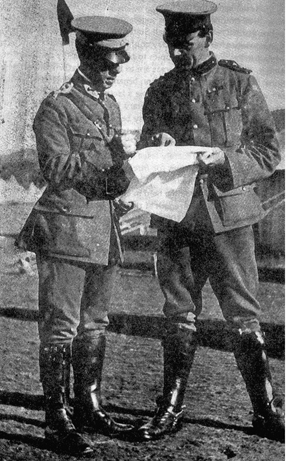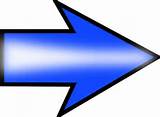|
- 80
-

The
man who wasn't there - Captain (later Major) GA Taylor
(left - he was
quite short of stature, but dapper), discussing military
matters with another
officer at an annual militia camp in outer Sydney
WHEN I
SAID above that Rosenthal and Scott were the two leaders
of the secret army that Lawrence encountered in Sydney
in May-June 1922, I had left out their organisation's
eminence gris, the principal ideologue of the
King & Empire Alliance - George Augustine Taylor.
While Taylor left Sydney a week before Lawrence arrived,
his influence pervades the novel. The words and ideas
that Lawrence puts into the mouth of Cooley in the
novel reflect, to a significant extent, the views
of George Augustine Taylor, as advanced in The
Sequel.
The Sequel is a diatribe, set at the beginning
of WW1, against what he calls "the Humanists"
- by which the author meant organised labour. Its
"hero" (the aviator Lieutenant Jefson) fears
a post-war future dominated by State socialism (which
he says had already begun to take over Australia,
with State bakeries, State brickworks, and other socialist
enterprises).
What was needed Taylor, proselytised in The Sequel,
was a capitalistic force that could recapture the
"civilised" world from the disasters, the
chaos, that would inevitably follow the rule of the
working-class. (This was written before the Russian
revolution, which event would have alarmed Taylor
even more.)
In The Sequel he indicated that his "capitalistic
force" would have a secret semi-military (or
para-military) core what would have the ability to
descend on meetings of "the Humanists" from
helicopters (then yet to be properly invented) and
wreak some harm on them.
I quote extracts from The Sequel:
| ...men
with more highly developed inventive faculties [Taylor,
of course, pictured himself as one of these folk],
men who wished to cultivate the spirit that inspires
the human to ever excel, met in mysterious places
and plotted...They felt that the time must inevitably
arrive when the unnatural social position the Humanists
adopted must overbalance itself, hence they prepared
for the impending cataclysm...the spark of invention
shone brightly in many covert places...Inventive genius
concentrated upon two objectives: first, an ideal
method of secret communication between followers;
and second, the most efficient fighting machine -
a weapon that would only require a minimum of personnel
to operate. With such a weapon, a small force, such
as the Individualists numbered, would be a match for
a multitude. |
Taylor's
"method of secret communication" was obviously
wireless, of which he was a pioneer in Australia. His
"efficient fighting machine" - a "weapon"
that "would only require a minimum of personnel to
operate" - was probably his yet-to-be-invented helicopter.
(At the time, Taylor was lobbying the Federal Government
to offer a prize for the first Australian-built commercial
aircraft, a condition of which competition would be that
the aircraft would need to hover.)

|
|